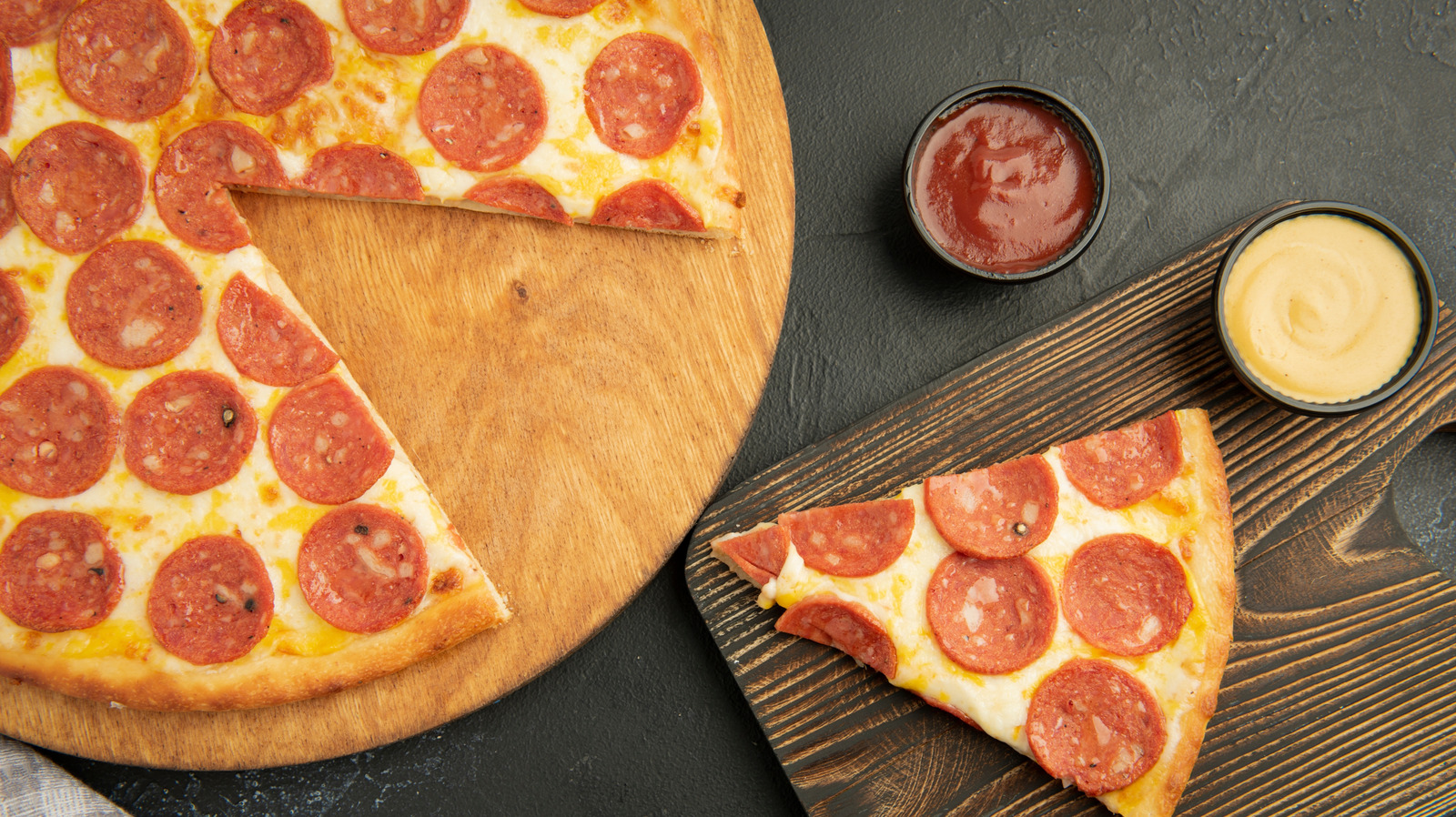Pizza is a food that’s beloved by many, and it’s easy to see why. You can customize the pie’s sauce base, stick with the classic shredded mozzarella or dive into more flavorful cheeses, and mix and match your toppings, but you can also complete your bite by serving it with a dipping sauce.
Pizza can stand on its own more comfortably than other foods commonly accompanied with dipping sauces, like fries and chicken nuggets. While it doesn’t necessarily need to have sauce, it’s always nice to know that you have the option to switch up your pizza routine by serving it with one. The sauce you select can reinforce the flavors in your toppings or take your bite in an entirely new and unexpected direction.
Whether you’re looking to step up your homemade pizza game or need inspiration for how to spruce up your mediocre delivery pie, we’ve got you covered. Here are some of the tastiest dipping sauces you can serve with your pizza, and advice on how to pair them with your pizza toppings of choice.
Ranch
Ranch dressing is arguably the most well-known pizza dipping sauce of all time — and for good reason. Its creamy base, accented with subtle dill and herb notes, is the perfect complement to an array of greasy pizza toppings. It works especially well with meat-based pies, like pepperoni, as the cooling sauce can cut through the fatty richness of the meat. Adding ranch to the equation is also an easy way to elevate your plain cheese pie, as it will infuse each bite with a herby flavor that pops on your taste buds.
Serve ranch as a side dipping sauce to your pie or artfully drizzled atop it. A squeeze bottle makes it easy to pipe fun swirls on your pizza, which is perfect for folks who aren’t necessarily head-over-heels in love with this dressing. Both store-bought ranch dressings and homemade recipes will work here. You can even try adding some tasty additions to alter its flavor profile and help it work better with your pizza toppings.
Garlic butter
We have a lot of love in our hearts for garlic butter — and how could you not? It’s arguably the best part about ordering a side of cheesy breadsticks from a takeout chain like Domino’s, and it turns out that butter can also elevate the flavor of your pizza. When you dip a piece of pizza into the garlic butter, you’ll give the crust a chance to soak up all that garlicky goodness. The benefits here are two-fold; not only will it enhance the savory flavor of the pie, but it will also soften a pizza crust that’s a little too crisp or dry. There are few pies that this dipping sauce won’t work well with.
Making your own garlic butter at home is simple. Melt down a few tablespoons and add fresh garlic to it. However, you can also alter its flavor by using roasted garlic (which will give you a more mellow, sweet flavor) or black garlic (which turns up the umami and sweetness factor).
Marinara sauce
Marinara sauce is a staple for pizza, and if you’re enjoying a red sauce pie, chances are that you already have enough of it to go around. But, if you want to drive that tomato flavor home even more, serve your pie with a side of it for dipping. There are several instances where this hack may come in handy.
For one, if you’re loading your pizza up with heavy and wet cheeses, like ricotta or fresh mozzarella, it may not be practical to slather the sauce on before you bake it. Dipping your slice into the sauce allows you to get a fresher, more acidic tomato flavor, since a sauce cooked in the oven will have a sweeter, more caramelized profile — which isn’t ideal for all toppings.
You don’t have to settle for lackluster pizza sauce for dipping, either. Try sauteing fresh garlic or adding fresh herbs to your sauce to help perk up its flavor.
Blue cheese dressing
Some people are big, big fans of blue cheese dressing. While we aren’t in that camp, we can see how the funky flavor of this salad dressing makes it an excellent dipping sauce for pizza. The cheese component is funky and rich, while its aromatic ingredients lend themselves well to an array of pizza toppings, including barbecue chicken, salty pepperoni, bacon, and caramelized onions. The sauce itself is creamy, similar to ranch, which will cut through greasy meats and cheeses with ease.
While pizza toppings can jive with the blue cheese dressing, there are others that you’re better off not getting involved with. These include mild-flavored vegetables, like zucchini, and pizzas topped with delicate or nuanced cheeses that you want to preserve the flavor of, like ricotta or gouda. Seafood also doesn’t pair well with blue cheese, as the two flavors clash too much to make them a worthwhile pairing.
Buffalo sauce
Buffalo chicken lovers are going to want to hear about this one. If you’re all about hot flavors in and around your pizza, try dipping your slice into Buffalo sauce. This buttery, red-hot condiment is a delectable addition to a slice that’s dripping with cheese and meaty toppings. It’s one of the few condiments on this list that could work just as well for a red pie as a white one, as its flavor is warm but not overtly tomato-y.
If you aren’t a fan of spicy things in general, you may not love this condiment. For a more controlled flavor, we recommend thinly drizzling it on your pie after it has come out of the oven. That way, you get just enough heat in every bite. You can also pair this sauce with other cooling ones, like ranch or blue cheese, to help quell its flavor and better complement a veggie-based or meaty pie.
Spicy mayo
Spicy mayo will offer your taste buds — and slice of pizza — the best of both worlds. If you believe that hot sauce is too hot, add a bit of mayo to help dial down its heat. The nice thing about spicy mayo is that you can whip it up yourself and adjust the levels of heat based on your personal preference. Or, swap out a funky fermented sauce like sriracha for something a little smokier, like a sauce made with chipotles and liquid smoke, to better suit your slice.
Hot sauce, arguably, goes with everything, and you may be surprised by the number of ways you can combine it with your pizza toppings. For example, you can try a shrimp pizza with arugula and bacon, served with a side of sriracha mayo. Or, try a barbecue lover’s pie with smoked meats and a complex, spicy-sweet mayo to cut through the richness of the pork or chicken.
Hot honey
Hot honey is having a moment, and we couldn’t be any happier for it. It’s the quintessential best-of-both-worlds scenario: sweet honey compounded by spicy, chile undertones. The two balance each other out; the chile prevents it from being too cloying while the sweetness prevents the spice from dominating the bite.
Hot honey is an especially delectable condiment to drizzle atop a loaded meat pizza, as the honey will cut through greasy pepperoni or ham and balance out the saltiness. We especially like drizzling it on a Hawaiian pizza, as the honey is the perfect complement to the floral notes in the pineapple, while the bacon and/or ham gets a decadent upgrade from the sticky-sweet spread.
Make hot honey at home by simmering down spicy chiles, ginger, and vinegar before adding honey and salt. This recipe keeps for about two weeks, but there are more than enough ways to use it in your kitchen to make whipping up a batch of it worthwhile. However, if you’re after a longer-lasting alternative, you can always pick up a trusted brand of hot honey, like Mike’s, from your local grocery store.
Alfredo sauce
Alfredo sauce is a sleeper hit in more ways than one. Not only can you use it for its intended purpose — as a pasta sauce — but you can also use it as a dipping sauce for fries, onion rings, mozzarella sticks, and of course, pizza. It’s creamy, rich, and fatty, which is just what you need to elevate a ho-hum slice. Plus, it’s easy to match up with an array of pizza toppings. For example, it would add an extra layer of decadence to a red or white-sauced pie topped with broccoli, sweet potatoes, peppers, tomatoes, and onions. Or, you can use it to cool off the bite of a savory and spicy Buffalo chicken pizza and amplify its cheesy notes.
Store-bought Alfredo sauce works just fine for your pizza sauce, and all you need to do is nuke it in the microwave before chowing down. You can also switch up your routine and try a more unique Alfredo — like one infused with roasted garlic, herbs, or even bacon — to better mesh with your toppings.
Barbecue sauce
Out of all of the condiments and sauces on this roundup, barbecue sauce arguably has the largest variation in flavor and composition. Not only will you find sauces that are tomato-leaning, but also ones that prioritize smokiness, tanginess, sweetness, or acidity. As such, it may take trial and error to find the perfect barbecue sauce for dipping your pizza in.
While we can’t necessarily say that one variety of barbecue sauce is better than the rest, we can point you in the direction of the best toppings to pair with it as a whole. Barbecue sauce, as its name implies, is made for meat — so your meat-za is primed for a pairing here. Think shredded barbecue pork (or jackfruit, for our fellow vegetarians out there), juicy chicken, and even a plain ground beef sprinkle paired with a sweet mesquite sauce. Some vegetable toppings, like caramelized onions and even mushrooms, might work. But broadly speaking, stay in the smoky and meaty family when you’re working with barbecue sauce since they are more agreeable to the complex, smoky, and rich flavor that it can offer.
Pesto
Pesto is one of our favorite tomato sauce alternatives to use on pizza. The sauce is easy to make — as it’s just a combination of basil, olive oil, Parmesan, lemon, and garlic — and it elevates every inch of pizza, whether nestled underneath cheese or used as a dipping sauce. While other sauces on this list are heavy, sweet, and very flavorful, pesto can offer a herby, light contrast to your pie. Since its flavor is so light, it’s best suited to a white pizza or one with an olive oil base, as tomato can sometimes overpower it. Pair it with creamy cheeses like brie, ricotta, or mozzarella for a delicious bite, or opt for a veggie lover’s rendition with sliced summer squash, red onions, and eggplant.
Pesto is eaten fresh, so it’s important to select a high-quality olive oil for it. We also like to hit ours with a ton of lemon juice, as this brightens the mouthfeel even more. However, you could stick to less if you’d rather have a savory, garlic-forward profile.
Tzatziki
Tzatziki is one of the more unique dipping sauces on this list, seeing as how it’s really only consumed cold. In other words, you can’t bake this Greek yogurt condiment on your pizza, as the acidic yogurt tends not to appreciate the heat of your oven as much as a pesto or a marinara sauce would. But what you can do is serve it in a little dish for dipping — and you’ll be glad you did.
This fresh sauce is bursting with herby flavor, thanks to the inclusion of fresh garlic and dill. Another ingredient that makes it unique is the chopped cucumbers, which help switch up the texture and offer the occasional crunch in between bites. It’s as refreshing as a dip can get, which makes it an excellent pairing for a greasy and otherwise uninspired slice of pizza. It would be tasty paired with Mediterranean-inspired toppings, like meaty Kalamata olives, grilled chicken, ground beef, artichokes, and feta, as the Greek yogurt would lighten the bright flavors and draw attention to the textures of the toppings.
Chimichurri
Chimichurri may be a condiment more associated with Argentina and grilled meats than Italy and pizza, but that doesn’t mean we can’t get a little fusion up in here. This herby condiment, made with garlic, vinegar, fresh herbs, and red chiles, is not the same thing as pesto. But if you like the herbal profile that pesto can offer pizza, you’ll like the spicy medley of oregano and parsley in chimichurri.
Since chimichurri is a mainstay for grilled meats, it’s going to be most comfortable with meaty toppings — like grilled chicken, chorizo, or carne asada. However, given that it has a zesty and bright mouthfeel, it can also help elevate a veggie-based pie, like one topped with roasted red peppers, sun-dried tomatoes, and squash. If you try your own recipe at home, you can tinker with the ratio of vinegar and garlic to get the perfect flavor for your pizza and respective toppings.
Thousand Island dressing
Thousand Island is a dressing that we admittedly forget about until we see it on a menu at a restaurant or walk past a container shoved in the back of a grocery store shelf. It’s essentially a hodge-podge of a whole bunch of condiments, all fused together into one sauce. You have ketchup for a slight umami and sweet flavor; mustard for spice and pep; and relish for … well … because why not. The result is a creamy condiment that goes with pretty much anything that its three respective components can go on — and more.
Pizza could benefit from the acidic pop of this dressing, while your taste buds will appreciate the contrast between the dressing’s creamy texture and the crunchy crust. An obvious topping pairing would be cheeseburger pizza, with ground beef, shredded lettuce added post-bake, onions, and tomatoes — but that’s far from the only pairing possible. It could offer a unique contrast to a Hawaiian pizza, too, as the pop of the relish would quell the sweetness of the fruit.
Chili oil
If you’re looking for a hot twist to your Asian-inspired pizza, pull out that jar of chili oil. This hot condiment is typically comprised of oil and chiles, as the name suggests, but may also include some other aromatic components as well, like garlic or onion. The oil will permeate through the crust and impart a piquant brightness to every bite.
You have to be somewhat careful with chili oil, as there are no other flavors to help mellow out the unadulterated and sometimes overwhelming heat. So, it’s not something you’ll want to use as a dip if your pie already has hot toppings. On the bright side, it is a great dip for a pizza topped with fatty cured meats, like pepperoni, sausage, or prosciutto. If you have an array of particularly bland veggies, like sweet potatoes, peppers, and eggplant, it can come in handy to perk up the bite. You may also pull inspiration from Asian-inspired pizza and try one with grilled chicken or shrimp and a drizzle of peanut sauce.
Balsamic
Balsamic is an excellent sauce to dip into or drizzle onto your pizza, especially if you’re packing on the veggies. Ideally, you’ll want to use a balsamic reduction, as it has sweet and tangy notes that will complement otherwise ho-hum veggies, from tomatoes and onions to thinly-shaved sweet potatoes and eggplant. It’s also in great company with Mediterranean-adjacent toppings, including prosciutto, feta, olives, as well as greens like spinach and arugula.
The best thing about a balsamic reduction is that it’s so easy to prepare at home. Simply simmer down balsamic vinegar on the stovetop until it’s thick and glossy. The result is a sauce that will cling to your pizza slice with ease, rather than make it soggy and drip off like a balsamic vinaigrette or plain vinegar would.
Chick-fil-A sauce
The dipping sauces are one reason to pay your local Chick-fil-A a visit — or you can always pick up a bottle of its signature Chick-fil-A sauce from your local grocery store. The dipping sauce has amassed a cult-like following. It’s a mixture of barbecue, honey mustard, and ranch (though some people just use regular mayo instead of ranch in their homemade variations) — which means it brings the best of all three condiments in one place. It’s creamy, decadent, and the perfect pairing for a pizza.
Like Thousand Island, you can dip your cheeseburger-inspired pizza into this sauce. Or, pair it with a grilled chicken pizza — try adding pickle slices post-bake for the full Chick-fil-A experience. It’s also an excellent pairing for smoky bacon, which will play off the barbecue undertones, as well as caramelized onions, which will cling to the sweetness of the honey mustard.





